Wafer-Level Packaging Method for RF MEMS Applications Using Pre-Patterned BCB Polymer
Abstract
:1. Introduction
2. Package Design
3. Packaging Process and Comparison with the Conventional Process
- (a)
- A layer of 50-nm thick silicon nitride (Si3N4) is deposited as the silicon etching mask by low pressure chemical vapor deposition (LPCVD) on both sides of the silicon cap wafer.
- (b)
- BCB is spin-coated at 2000 rpm (rounds per minute) and patterned through standard photolithography with UV (Ultraviolet Rays) lights.
- (c)
- The Cr and Au layer is sputtered successively on the cavity side of the wafer to form the adhesion layer and the hard mask layer to protect the BCB during the silicon etching. After this, the Cr/Au layer and Si3N4 layer are patterned to create the opening for the following cavity etching.
- (d)
- Tetramethyl ammonium hydroxide (TMAH) anisotropic etching is used to manufacture the cavities on the cap wafer.
- (e)
- The pre-patterned BCB process on the cap wafer is finished after the removal of the Cr/Au layer with the corresponding solution.
- (f)
- The cap wafer is bonded to the device glass wafer with CPW structures in a wafer level.
- (g)
- AZ4620 with a thickness of 8 μm is spin-coated and patterned to define the areas on the cap wafer above the electrical pads of the device wafer. After this, the cap wafer is partially diced to provide access to the electrical pads by adjusting the height of wafer dicing saw to the device wafer.
- (h)
- Finally, the device wafer is diced to yield individual 0-level packaged RF MEMS devices.
- (1)
- Low processing temperature compared to the chemical vapor deposition of Si3N4 or SiO2.
- (2)
- Chemically resistant enough for the wet-etching process as the polymer would react with the alkaline solution, which makes it unsuitable to serve as the mask layer in TMAH.
- (3)
- Excellent step coverage ability: the sputtering method can provide a good coverage for the side wall of the BCB sealing ring.
- (4)
- Process compatibility with BCB: Au and Cr can be removed successively by potassium iodide (KI) and diluted nitric acid (HNO3) with no effect on the BCB polymer.
4. Results and Discussions
4.1. Bonding Quality
4.2. RF Characterization and Reliability of Packaged RF MEMS Switch
5. Conclusions
Acknowledgments
Author Contributions
Conflicts of Interest
References
- Tilmans, H.A.C.; Ziad, H.; Jansen, H.; Di Monaco, O.; Jourdain, A.; De Raedt, W.; Rottenberg, X.; De Backer, E.; Decaussernaeker, A.; Baert, K. Wafer-level packaged RF-MEMS switches fabricated in a CMOS fab. In Proceedings of the International Electron Devices Meeting, Washington, DC, USA, 2–5 December 2001; pp. 41.4.1–41.4.4. [Google Scholar]
- Kim, K.I.; Kim, J.M.; Kim, J.M.; Hwang, G.C.; Baek, C.W.; Kim, Y.K. Packaging for RF MEMS devices using LTCC substrate and BCB adhesive layer. J. Micromech. Microeng. 2005, 16, 150–156. [Google Scholar] [CrossRef]
- Jourdain, A.; Ziad, H.; De Moor, P.; Tilmans, H.A.C. Wafer-scale 0-level packaging of (RF-) MEMS devices using BCB. In Proceedings of the Design, Test, Integration and Packaging of MEMS/MOEMS Symposium on IEEE, Cannes, France, 5–7 May 2003; pp. 239–244. [Google Scholar]
- Oya, Y.; Okubora, A.; Van Spengen, M.; Soussan, P.; Stoukatch, S.; Rottenberg, X.; Ratchev, P.; Tilmans, H.; De Raedt, W.; Beyne, E.; et al. A reliable and compact polymer-based package for capacitive RF-MEMS switches. In Proceedings of the International Electron Devices Meeting, San Francisco, CA, USA, 13–15 December 2004; pp. 31–34. [Google Scholar]
- Wunnicke, O.; Kwinten, H.; van Leuken-Peters, L.; In’t Zandt, M.; Reimann, K.; Aravindh, V.; Suy, H.M.R.; Goossens, M.J.; Wolters, R.A.M.; Besling, W.F.A.; et al. Small, low-ohmic RF MEMS switches with thin-film package. In Proceedings of the Micro Electro Mechanical Systems (MEMS) Conference, Cancun, Mexico, 23–27 January 2011; pp. 793–796. [Google Scholar]
- Esashi, M. Wafer level packaging of MEMS. J. Micromech. Microeng. 2008, 18, 073001. [Google Scholar] [CrossRef]
- Bleiker, S.J.; Taklo, M.M.V.; Lietaer, N.; Vogl, A.; Bakke, T.; Niklaus, F. Cost-Efficient Wafer-Level Capping for MEMS and Imaging Sensors by Adhesive Wafer Bonding. Micromachines 2016, 7, 192. [Google Scholar] [CrossRef]
- Lee, B.; Seok, S.; Chun, K. A study on wafer level vacuum packaging for MEMS devices. J. Micromech. Microeng. 2003, 13, 663–669. [Google Scholar] [CrossRef]
- Wang, Q.; Choa, S.H.; Kim, W.; Hwang, J.; Ham, S.; Moon, C. Application of Au-Sn eutectic bonding in hermetic radio-frequency microelectromechanical system wafer level packaging. J. Electron. Mater. 2006, 35, 425–432. [Google Scholar] [CrossRef]
- Muldavin, J.; Bozler, C.; Rabe, S.; Keast, C. Wide-band low-loss MEMS packaging technology. In Proceedings of the 2005 IEEE MTT-S International, Long Beach, CA, USA, 12–17 June 2005; pp. 765–768. [Google Scholar]
- Wu, G.; Xu, D.; Sun, X.; Xiong, B.; Wang, Y. Wafer-level vacuum packaging for microsystems using glass frit bonding. IEEE Trans. Compo. Packag. Manuf. Technol. 2013, 3, 1640–1646. [Google Scholar] [CrossRef]
- Niklaus, F.; Stemme, G.; Lu, J.Q.; Gutmann, R.J. Adhesive wafer bonding. J. Appl. Phys. 2006, 99, 031101. [Google Scholar] [CrossRef]
- Cakmak, E.; Dragoi, V.; Capsuto, E.; McEwen, C.; Pabo, E. Adhesive wafer bonding with photosensitive polymers for MEMS fabrication. Microsyst. Technol. 2010, 16, 799–808. [Google Scholar] [CrossRef]
- Jourdain, A.; De Moor, P.; Baert, K.; De Wolf, I.; Tilmans, H.A.C. Mechanical and electrical characterization of BCB as a bond and seal material for cavities housing (RF-) MEMS devices. J. Micromech. Microeng. 2005, 15, S89–S96. [Google Scholar] [CrossRef]
- Seok, S.; Rolland, N.; Rolland, P.A. A novel packaging method using wafer-level BCB polymer bonding and glass wet-etching for RF applications. Sens. Actuators A. 2008, 147, 677–682. [Google Scholar] [CrossRef]
- Oberhammer, J.; Stemme, G. BCB contact printing for patterned adhesive full-wafer bonded 0-level packages. J. Microelectromech. Syst. 2005, 14, 419–425. [Google Scholar] [CrossRef]
- Niklaus, F.; Enoksson, P.; Kälvesten, E.; Stemme, G. Low-temperature full wafer adhesive bonding. J. Micromech. Microeng. 2001, 11, 100–107. [Google Scholar] [CrossRef]
- Available online: https://www.dow.com/cyclotene/prod/402440.htm (accessed on 21 February 2018).
- Jourdain, A.; Rottenberg, X.; Carchon, G.; Tilmans, H.A. Optimization of 0-level packaging for RF-MEMS devices. In Proceedings of the Transducers, Solid-State Sensors, Actuators and Microsystems Conference, Boston, MA, USA, 8–12 June 2003; pp. 1915–1918. [Google Scholar]
- Fischer, K.; Suss, R. Spray coating-a solution for resist film deposition across severe topography. In Proceedings of the Electronics Manufacturing Technology Symposium, San Jose, CA, USA, 14–16 July 2004; pp. 338–341. [Google Scholar]
- Guo, X.; Gong, Z.H.; Zhong, Q.; Liang, X.T.; Liu, Z.W. A miniaturized reconfigurable broadband attenuator based on RF MEMS switches. J. Micromech. Microeng. 2016, 26, 074002. [Google Scholar] [CrossRef]
- Mulloni, V.; Giacomozzi, F.; Margesin, B. Controlling stress and stress gradient during the release process in gold suspended micro-structures. Sens. Actuators A 2010, 162, 93–99. [Google Scholar] [CrossRef]
- Mulloni, V.; Sordo, G.; Margesin, B. An accelerated thermal cycling test for RF-MEMS switches. Microsyst. Technol. 2016, 22, 1585–1592. [Google Scholar] [CrossRef]
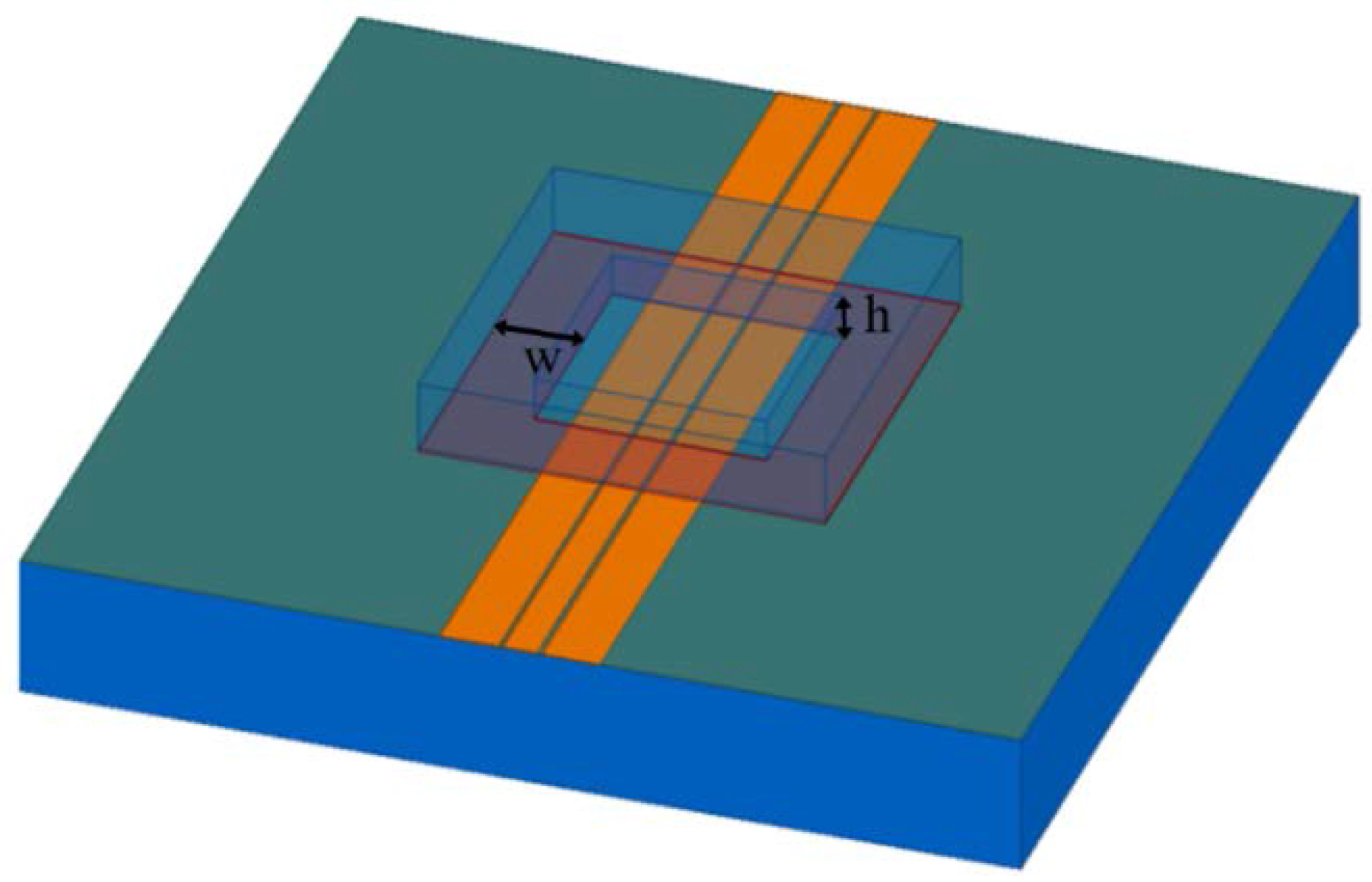
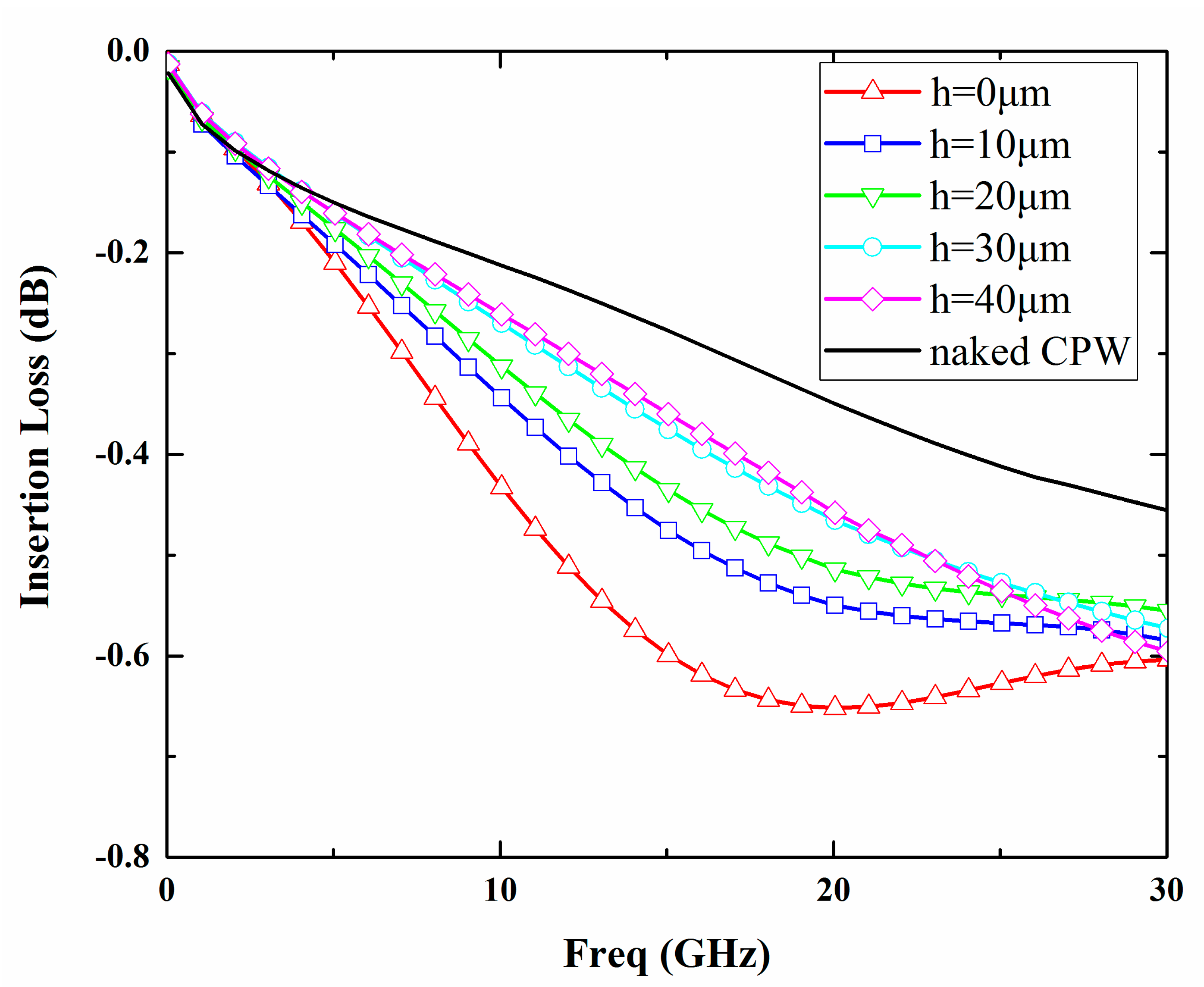
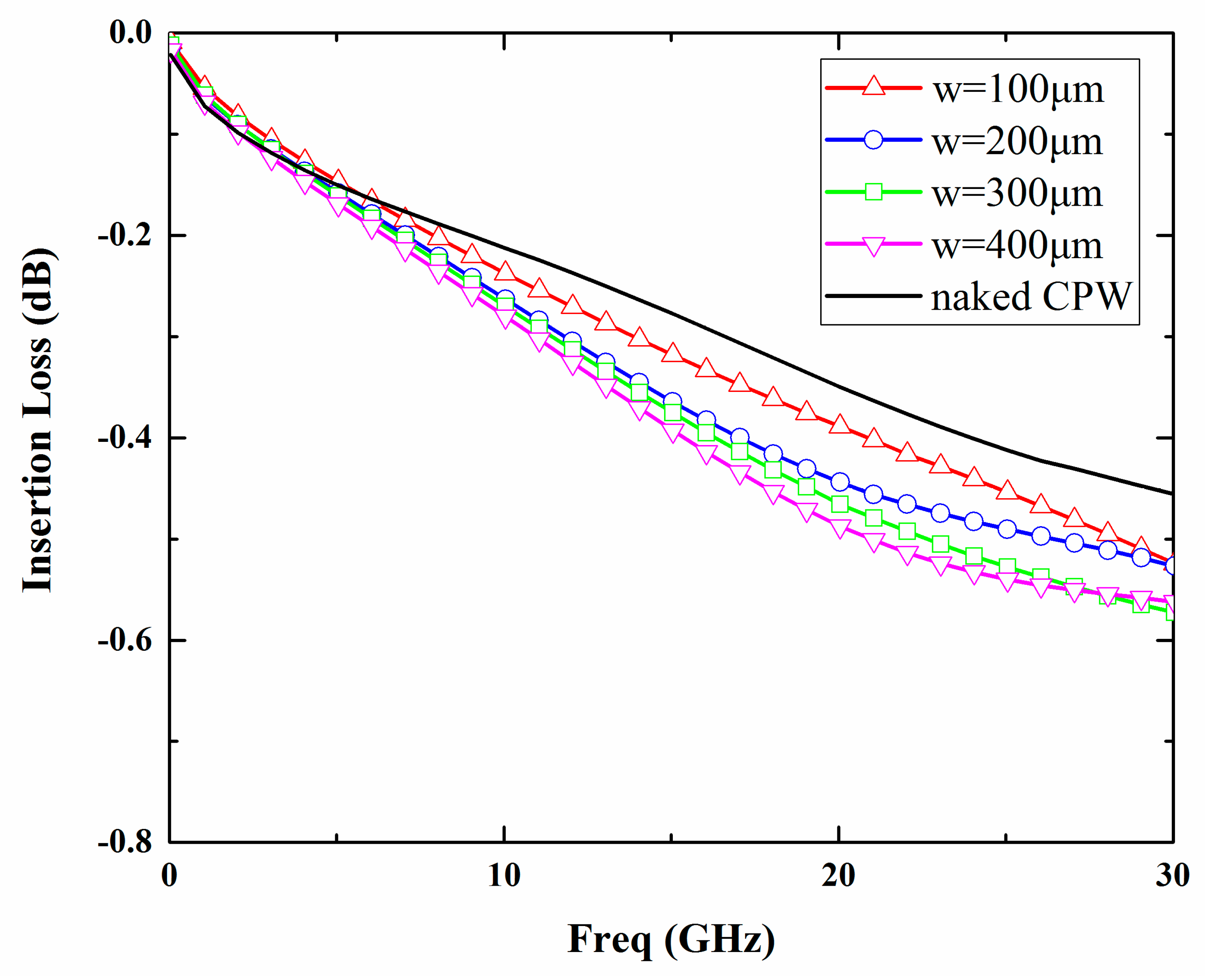
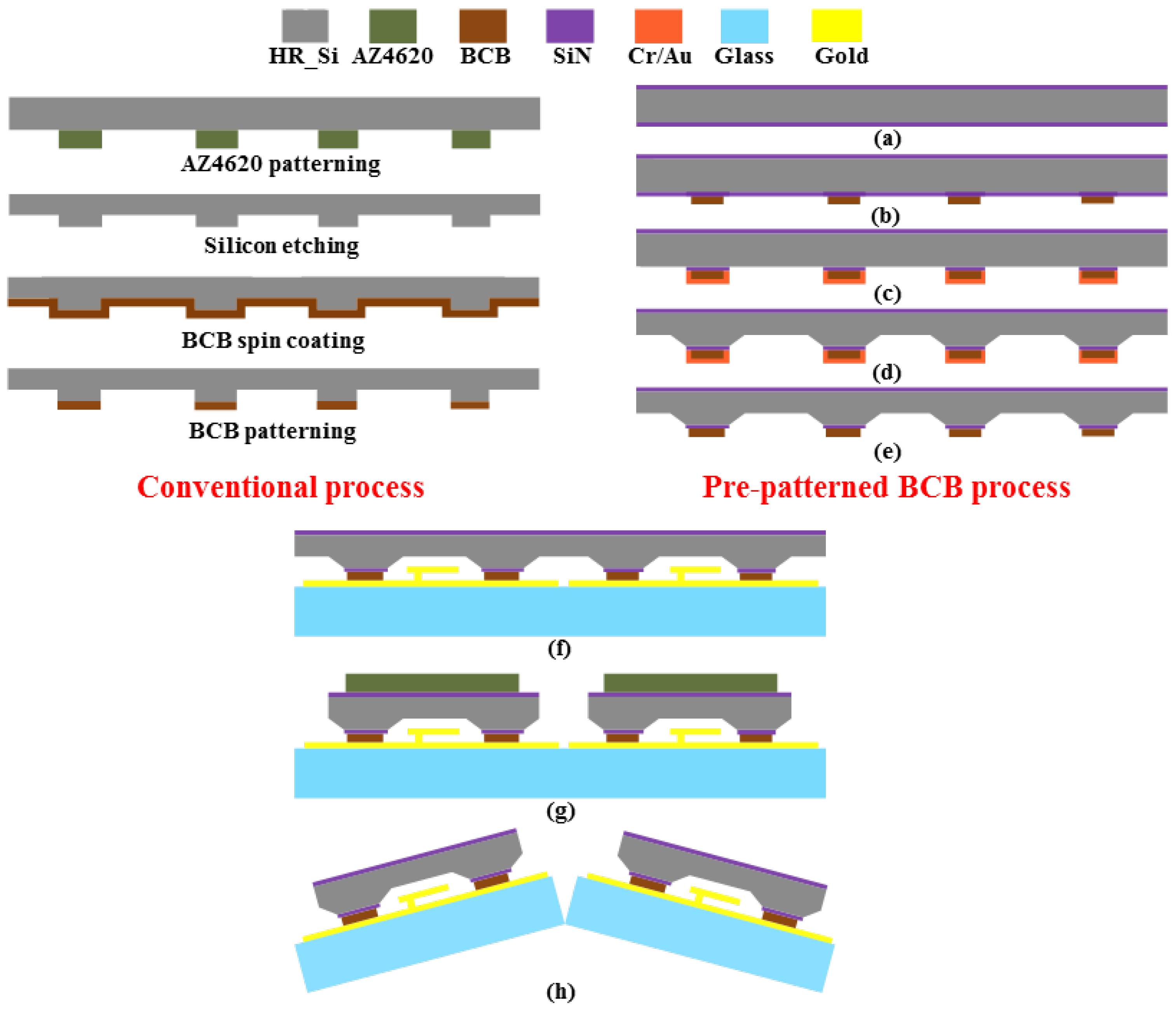
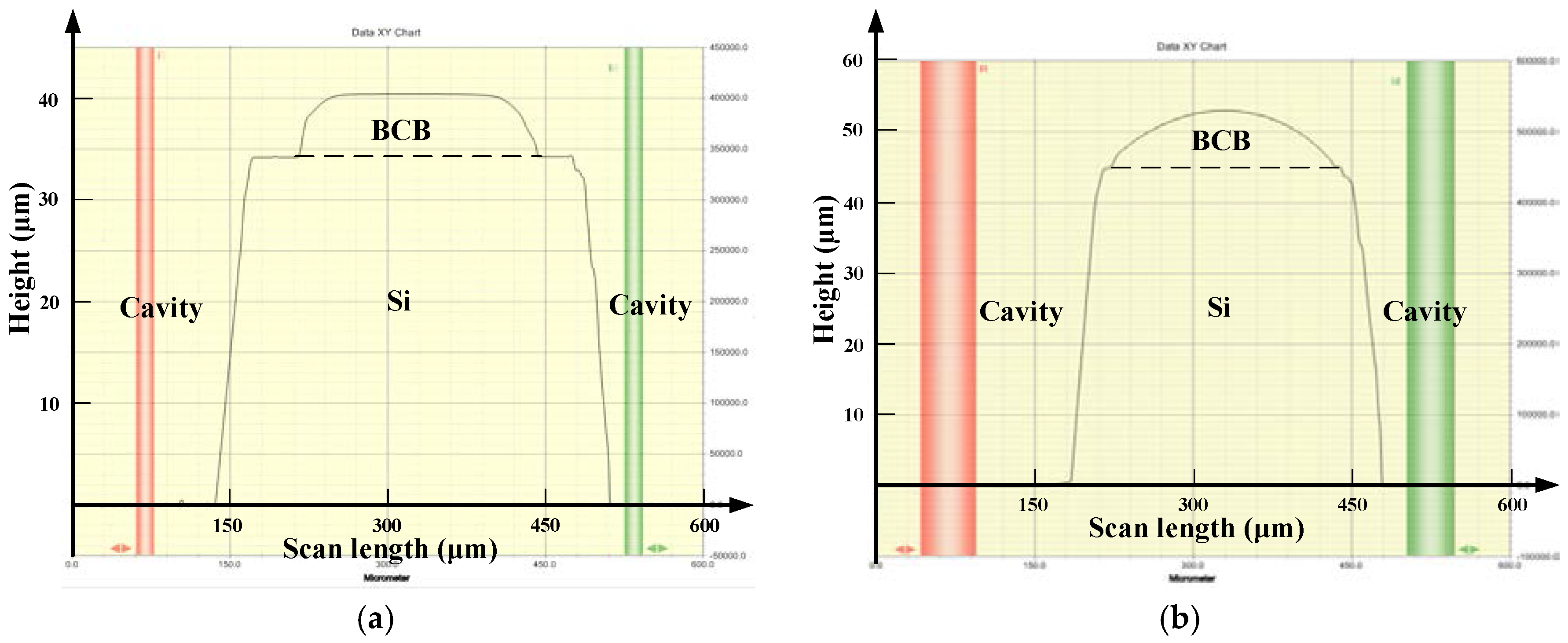
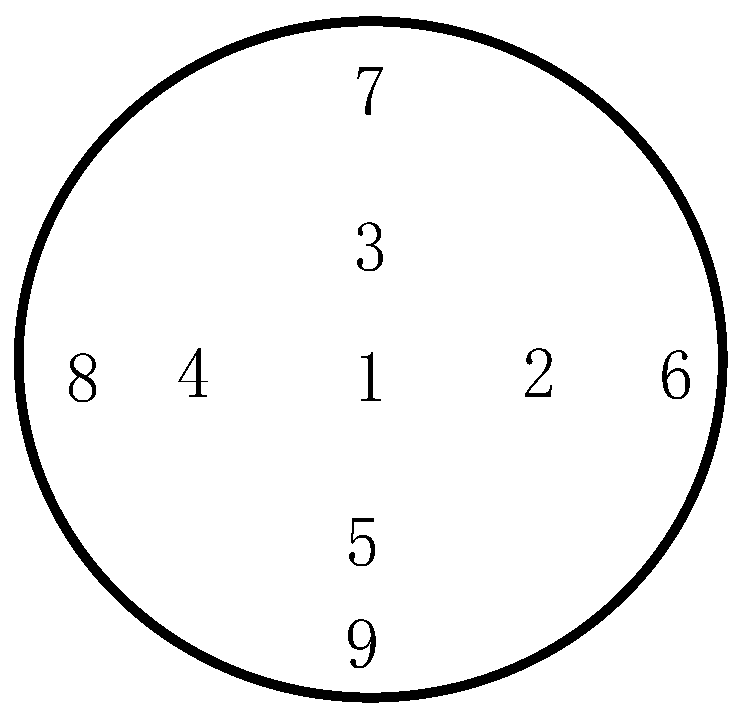




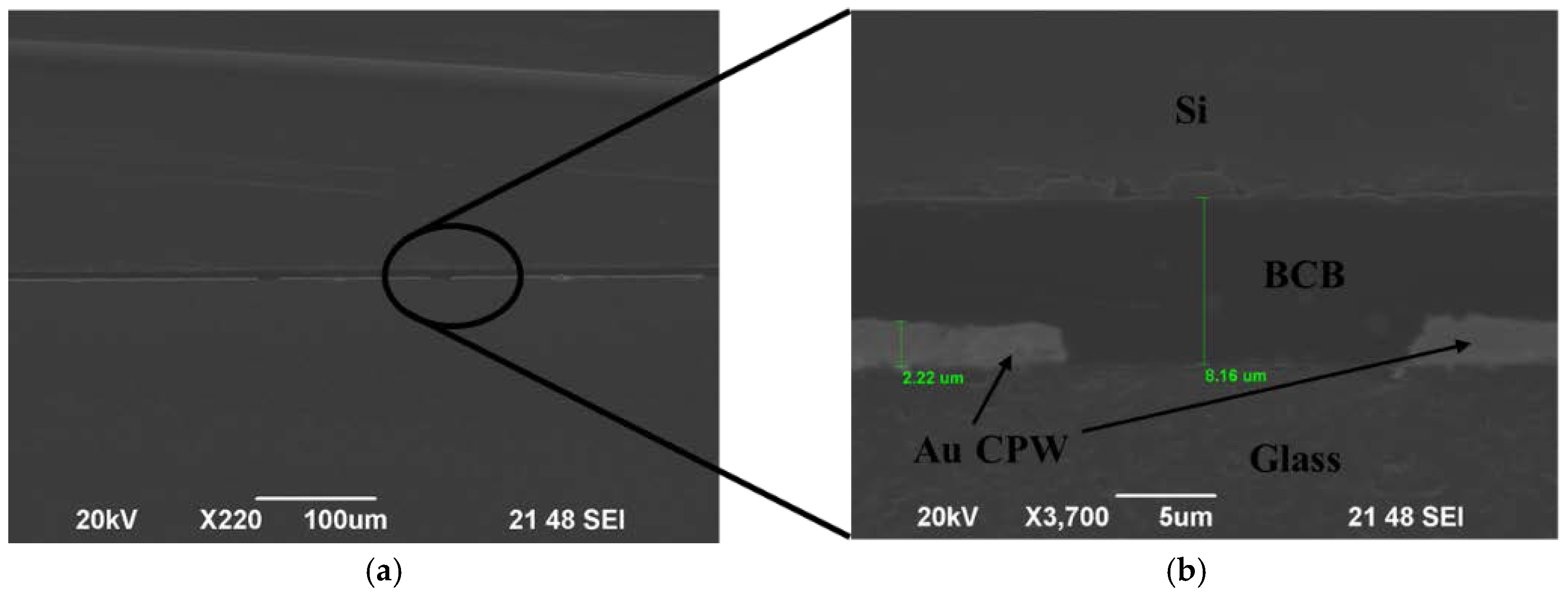
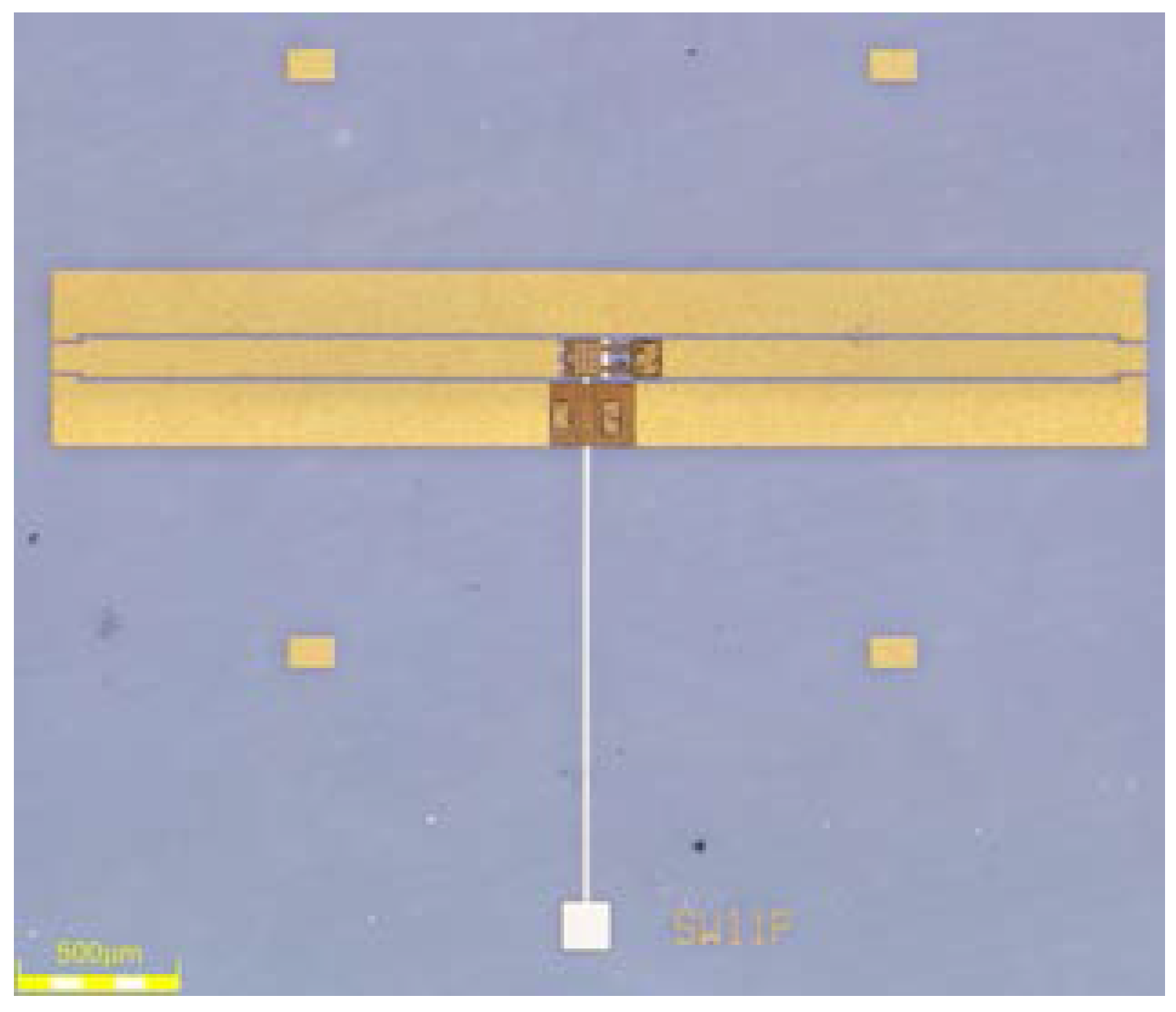

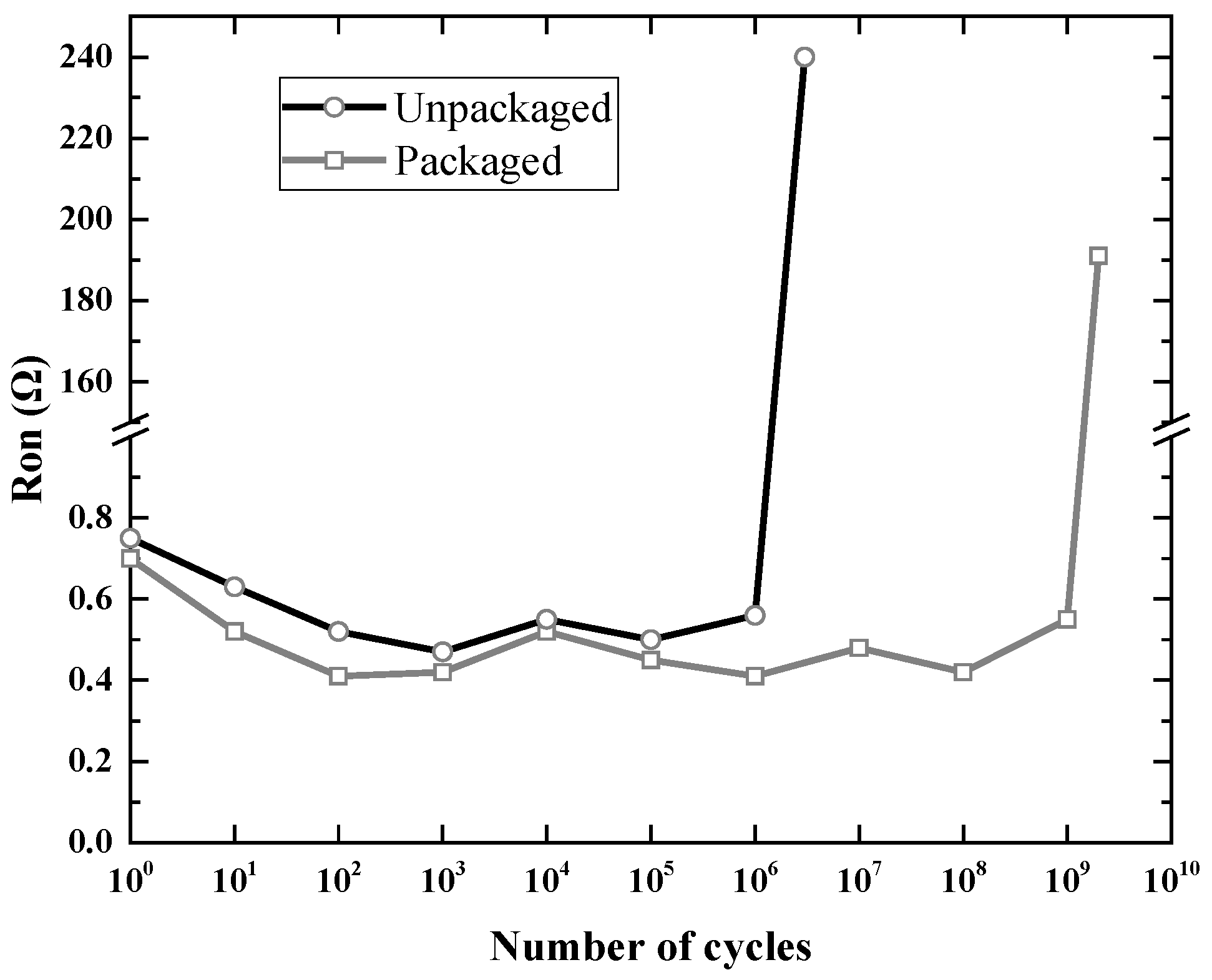
| Adhesion Promoter (AP3000 a) | 3000 rpm, 20 s |
|---|---|
| BCB (4024-40) spin coating | 2000 rpm, 30 s |
| Soft bake | 70 °C, 90 s |
| Expose | 210 mJ/cm2 |
| Pre-develop bake | 60 °C, 60 s |
| Immersion develop (DS3000 a) | 38 °C, 200 s |
| Post-develop bake | 90 °C, 60 s |
| Measurement Points | 1 | 2 | 3 | 4 | 5 | 6 | 7 | 8 | 9 | Avg | σ |
|---|---|---|---|---|---|---|---|---|---|---|---|
| Pre-patterned BCB process (μm) | 7.29 | 6.72 | 7.00 | 7.18 | 7.36 | 6.96 | 6.93 | 7.22 | 7.10 | 7.08 | 0.2016 |
| Conventional process (μm) | 10.32 | 9.18 | 8.50 | 9.53 | 8.07 | 8.34 | 8.28 | 7.62 | 8.12 | 8.66 | 0.8497 |
| BCB Width (μm) | Bonding Area (mm2) | Parallel to the CPW Line | Vertical to the CPW Line | ||
|---|---|---|---|---|---|
| Shear Force (kgf) | Shear Strength (MPa) | Shear Force (kgf) | Shear Strength (MPa) | ||
| 100 | 0.3776 | 1.637 | 42.49 | 2.109 | 54.74 |
| 200 | 0.8352 | 2.265 | 26.58 | 2.881 | 33.80 |
| 300 | 1.3728 | 3.265 | 23.31 | 4.199 | 29.98 |
| 400 | 1.9904 | 4.383 | 21.58 | 4.993 | 24.58 |
© 2018 by the authors. Licensee MDPI, Basel, Switzerland. This article is an open access article distributed under the terms and conditions of the Creative Commons Attribution (CC BY) license (http://creativecommons.org/licenses/by/4.0/).
Share and Cite
Gong, Z.; Zhang, Y.; Guo, X.; Liu, Z. Wafer-Level Packaging Method for RF MEMS Applications Using Pre-Patterned BCB Polymer. Micromachines 2018, 9, 93. https://doi.org/10.3390/mi9030093
Gong Z, Zhang Y, Guo X, Liu Z. Wafer-Level Packaging Method for RF MEMS Applications Using Pre-Patterned BCB Polymer. Micromachines. 2018; 9(3):93. https://doi.org/10.3390/mi9030093
Chicago/Turabian StyleGong, Zhuhao, Yulong Zhang, Xin Guo, and Zewen Liu. 2018. "Wafer-Level Packaging Method for RF MEMS Applications Using Pre-Patterned BCB Polymer" Micromachines 9, no. 3: 93. https://doi.org/10.3390/mi9030093





